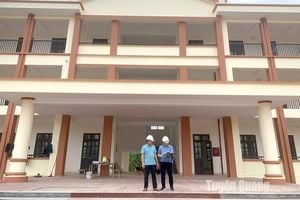WANDERLAND, Peru — After weeks of living in jungle tents, the handful of Mennonite families trying to make a new home deep in the Peruvian Amazon began to despair. Wasps attacked as they tried to clear forest. Heavy rains turned the road to their camp to mud.
Running low on supplies, some wanted to turn back. Instead, they worked harder and eventually carved out an enclave.
“There’s a place here where I wanted to live, so we came and opened part of it up,” recalled Wilhelm Thiessen, a Mennonite farmer. “That’s what everyone did to have a place to live.”
Today, seven years later, the cluster of homesteads is now a thriving colony, Wanderland, home to roughly 150 families, a church— which doubles as a school— and a cheese-processing facility. It is one of a string of Mennonite settlements taken root throughout the Amazon, turning forest land to thriving farms but also raising concerns among environmentalists about deforestation of habitats already under threat from industries such as cattle ranching and illegal gold mining.
Peruvian authorities are keeping close tabs on Mennonite communities, investigating several and accusing them of clearing forest without the necessary permits. The colonies, for their part, deny any wrongdoing.
The Mennonites first began migrating to Latin America from Canada about a century ago. This was after the country ended their exemptions from education requirements and military service.
Then, President Álvaro Obregón of Mexico, aiming to consolidate rebellious northern regions following the Mexican Revolution, offered Mennonites uncultivated land and guarantees to live as they pleased. Following this, several Latin American countries extended similar invitations to broaden their agricultural frontiers.
According to research from McGill University, over 200 Mennonite colonies now occupy about 9.64 million acres throughout nine Latin American countries—an expanse larger than the Netherlands, their denomination’s original home. Bolivia has experienced the fastest growth, boasting 120 colonies, and within the past decade, several settlements, including Wanderland, have sprouted up in Peru.
Mennonites have also sought land rich with unspoiled forests, like Suriname, causing uproar from Indigenous groups and Maroons, descendants of enslaved people. “They’re basically trying to find the last places on Earth with large, continuous areas supporting their lifestyle, which just happens to be forested areas in the Amazon,” mentioned Matt Finer, senior research specialist at Amazon Conservation, an environmental nonprofit.
On the ground, Wanderland resembles life from the past. Horse-drawn buggies transport people along the dirt tracks, and men clad in overalls work the fields behind simple wooden homes.
No electricity gives the nights a unique charm as families gather for dinner by candlelight following grace spoken in Plautdietsch, the Germanic dialect exclusively used by Mennonites across the Americas. Evidence of the wild persists, with pet monkeys on porches and caged parrots adding to the rustic ambiance.
Johan Neufeld, 73, takes pride in his backyard, showcasing three lowland pacas—large Amazonian rodents sought for their meat. Having caught them from the forest, he is eager to breed them.
Wanderland is classified as an “Old Colony” settlement, comprised of Mennonites tracing their lineage back to the 18th-century Chortitza settlement, now part of Ukraine. Like their kin, they adhere closely to the teachings of Menno Simons, who faced persecution during the Reformation for opposing military conscription and infant baptism.
Living separately from broader society and resisting modern technology became hallmarks of their culture over time, with migration serving as a method for maintaining these traditions. “Our ancestors thought if we lived far away, there’s more possibility of controlling evil,” explained Johan Bueckert, an Old Colony farmer now residing in Providencia, another nearby colony.
He continued, “We want to live like they did. We don’t want constant change.”
With growing populations and prosperity, the land values surrounding these colonies surge, making it trickier for them to stick to their frugal farming lifestyle on affordable plots. Consequently, groups often splinter off to create new settlements.
Thiessen was integral to founding Wanderland after moving from Nueva Esperanza, one of Bolivia’s larger Mennonite communities. “There are many colonies but almost no land left in Bolivia,” he remarked.
Facing worldly temptations—especially smartphones—as Bolivian colonies became more congested became troubling, according to Hernan Neufeld, 39, one of Wanderland’s bishops. “Many brothers and sisters lost their way,” he noted. “That’s why we sought a more remote place to see if we can enforce our norms.”
Since the first Mennonite settlements arrived in the Peruvian Amazon back in 2017, they have cleared over 17,000 acres of forest, as highlighted by last year's analysis from the Monitoring of the Andean Amazon Project (MAAP), monitoring deforestation. This figure, albeit significant, is but a fraction of the at least 370,000 acres cleared for small-scale farming across Peru.
The larger concern for environmental advocates is the overall deforestation of the Amazon, known for absorbing carbon emissions, which aids climate regulation on a global scale. Mennonites interviewed expressed unfamiliarity with the term “climate change” or the impacts of their activities on the Amazon ecosystem.
Mennonite leaders acknowledged they had cleared parts of the forest, yet they viewed their actions as minimal. “Every colony clears the forest a little bit, but it’s very little,” said Peter Dyck, leader of the Providencia colony.
He added, “The forest is big.” Their colonies cultivate crops like soy, rice, and corn to contribute to Peru’s food supply and stimulate the economy.
Despite this, the Mennonites are under increasing government scrutiny. Authorities are probing Wanderland, Providencia, and another colony for allegations of unauthorized forest clearing, searching for reparations and potential prison terms for leaders.
While maintaining their innocence, the colonies argue they require no permits due to holding agricultural titles to their land from regional governments. Medelu Saldaña, local political advisor to the colonies, noted they purchased their land from logging companies who had already removed hardwood trees.
Yet, experts and officials claim satellite images demonstrate these colonies have cleared primary forest rich in carbon. Even if parts were already compromised by logging activities, the colonies must still acquire permits and approvals due to the scale of their operations.
“They want a piece of paper to trump reality,” stated Jorge Guzman, lawyer for Peru’s environmental ministry.
Some experts focusing on Mennonite communities believe they face unfair stigmatization, pointing out other activities in the Peruvian Amazon consume far larger forest areas. Palm and cacao plantations supplying global companies have taken over vast tracts of land, alongside illegal activities like drug trafficking, logging, and mining continuing to invade the region.
A few hours' travel downstream from Wanderland, another Mennonite village, Salamanca, is developing. Cornelius Niekoley, farmer and bishop from Mexico, visited Peru to evaluate potential land purchases for his adult children.
“Good price and nice land,” said Niekoley. “Not too many rocks. With too many rocks, it’s hard to clear the land.”
Born to a Mexican father and Canadian mother, Niekoley nurtures his family within their colony located in Quintana Roo, southeastern Mexico. Neighbors have initiated migration to Salamanca, seeking more affordable land.
Observing the village, he remarked, “There still aren’t many, but more are going to come.”



